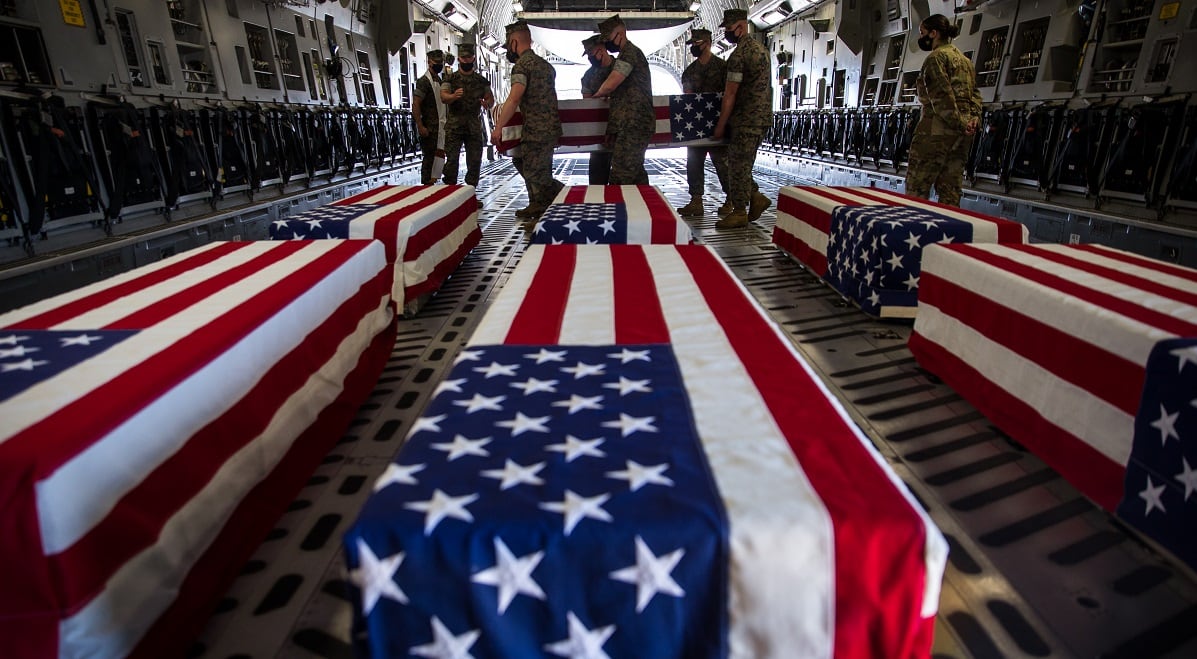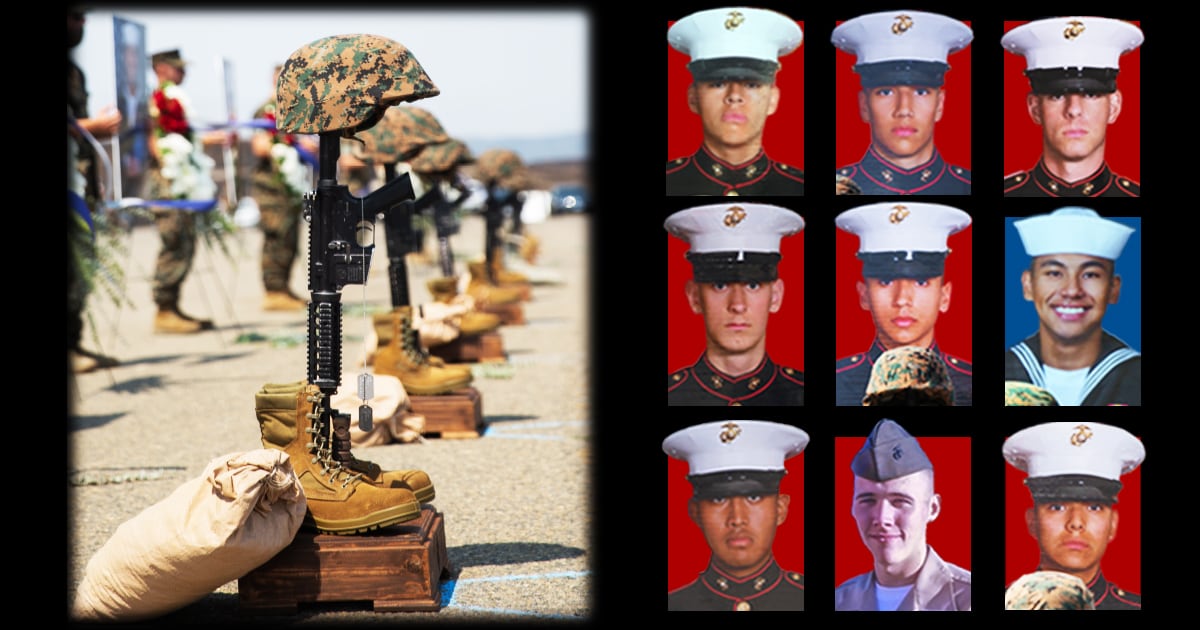Lawyers representing families of the service members who died in a July 2020 amphibious assault vehicle accident recently filed a lawsuit against BAE Systems, the manufacturer of the vehicle, citing a design flaw in the top cargo hatch.
The lawyers also called for the Corps to cease all waterborne training for the AAV and its replacement, the amphibious combat vehicle, also produced by BAE Systems, until the alleged cargo hatch flaw can be fixed.
The families claim the defect prevented the eight Marines and one sailor who died on July 30, 2020, from escaping as the vehicle slowly sank in waves off San Clemente Island, California.
RELATED

The Marines and sailor were attached to the 15th Marine Expeditionary Unit and were returning to the amphibious transport dock Somerset after conducting a training raid on the California island when a series of events led the AAV to first stall in the water, then eventually sink with 11 service members still onboard.
A lengthy investigation from the Marine Corps found the vehicles chosen for the 15th MEU deployment were picked up off a deadline lot and rushed into serviceability prior to the training operation.
The vehicle that sank was found to have several leaks that should have deadlined it before it left that morning.
Leaks, along with a seized transmission, caused the vehicle to stop in the water well short of the Sommerset. The stall caused the forward bilge pumps to stop working, eventually water hit the generator taking the rear bilge pumps off-line, the investigation found.
Still in the ocean, with water slowly filling the vehicle, two AAVs came to provide assistance, as no safety boats were in the water that day. One of the helping AAVs hit the sinking vehicle, turning it broadside into the waves.
One wave hit the vehicle broadside and the AAV quickly sank to the bottom of the ocean.
Three service members managed to escape, with one of the Marines dying shortly after the incident.
The investigation also found several issues with the training the Marines had received prior to the accident.
Only 11 of the 13 service members embarked on the AAV had up-to-date swim qualifications, while only two of the Marines from BLT 1/4 had genuinely completed the required underwater egress training.
The focus of the lawsuit will be on a cargo hatch problem. The lawyers alleged BAE Systems knew about the issue for decades.
From when the rear crewman first noticed the excess water to the vehicle going under took a total of roughly 45 minutes, according to the investigation.
The investigation suggested it was the vehicle commander’s hesitance to fully evacuate the sinking vehicle that prevented the Marines from escaping at that point.
Annee Della Donna, one of the lawyers representing the families, said the real reason the Marines did not escape at the first sign of water was a difficult lock that sometimes requires a hammer to force open.
Once open, there is no way to lock the door in place, Della Donna said at the press conference.
“Instead for 45 minutes they sat in this dark coffin and slowly sank to the bottom of the ocean,” Della Donna said.
The lawyer, citing her own interviews with witnesses, said four Marines were holding open the cargo hatch when the wave swept them off the vehicle, forcing the door shut and dooming those inside.
Della Donna claimed BAE Systems has known about the flaw for decades but opted not to fix the problem while, taking “billions of dollars from U.S. taxpayers to build these death traps.”
“They were put in a death trap,” said Eric Dubin, another lawyer for the families.
“This AAV had a design defect that BAE had known about for a long time,” Dubin added.
Tim Paynter, the vice president of external communications for BAE Systems, declined to comment on the lawsuit.
“We offer our deepest sympathies to the families impacted by this tragedy and we mourn the loss of the nine service members,” Paynter said in a Thursday email.
“We are not in a position to comment on ongoing litigation. The U.S. Marine Corps has conducted an investigation into this incident and we would ask you to contact them with any questions directly related to the incident,” he added.
Dubin said the families of the service members who died are simply looking for “accountability and justice” and called on the Marine Corps to join them in their pursuit to fix the alleged design flaw.
“We are not suing the military, in fact quite the opposite we are hopeful that the military joins in what we are asking for, which is safety modifications,” Dubin said.
The lawyers want the outward opening doors to be changed to ones that will open and lock inward, which would prevent the doors from being locked shut by water pressure as a future vehicle sinks into the ocean.
Until the flaws can be fixed the lawyers and families called on the Marine Corps to cease all waterborne training with either the AAV or the ACV.
“We, the families, the mothers, the fathers, the brothers, the sisters are calling on the U.S. military to beach every single AAV,” Della Donna said. “If we have to stop them going into the water, we will lock arms and stop them going into the water until these changes are made.”
The Marine Corps declined to comment on the lawsuit.
“As a matter of policy, we do not comment on pending litigation. We continue to mourn the loss of the 8 Marines and 1 Sailor who tragically died on July 30, 2020,” Maj. James Stenger told Marine Corps Times.
After the incident the Marine Corps stopped all waterborne training with the AAV until an investigation could be completed.
Once the investigation was done, every AAV in the fleet was re-evaluated with a new increased standard based on the investigation’s findings.
“A majority of the AAVs failed to meet the new inspection criteria,” Lt. Gen. Steven Rudder, commander of Marine Forces Pacific, said in the investigation.
The most common failures were, “bilge pump discrepancies, inoperable emergency egress lighting systems and plenum leakage,” all problems the doomed the AAV that sank on July 30, 2020.
In June III Marine Expeditionary Force stated sending its AAVs back into the water, claiming it had fixed the problems that had plagued the sunken AAV.
“U.S. Marines with Company B, 3d Assault Amphibian Battalion, completed a demanding waterborne operations training package June 8, 2021, on Okinawa, Japan, in compliance with all updated policies and procedures, effectively returning an important capability to III MEF,” the MEF said in a June news release.
The 1st Marine Division also has re-started waterborne training after putting its Marines through a new training program, the Orange County Register previously report.
Multiple investigations found individual Marines at fault, which led the Corps to relieve several commanders, including Col. Christopher J. Bronzi, the former commander of the 15th MEU, and Maj. Gen. Robert Castellvi, from his position as inspector general of the Marine Corps.
Castellvi was the commander of the 1st Marine Division when the Marines and sailor who died in the AAV accident conducted their pre-deployment training.
Despite any fault, the controversial Feres Doctrine makes that route difficult if not impossible for the families.
The Feres Doctrine dates back to a 1950s Supreme Court decision that historically has been used to block the Defense Department from wrongful death lawsuits.
In May, lawmakers discussed using the power of Congress to amend the Feres Doctrine in cases similar to the AAV sinking.
Rep. Joe Courtney, D-Connecticut, said the antiquated part of the law goes back to a 1950s Supreme Court decision and “really needs to be updated and modernized.”
Rep. Jackie Speier, D-California, agreed.
“We need to expand (Feres Doctrine reform) to deal with gross negligence in situations like this,” Speier said. “There is a hefty price tag that comes with it of course, but the lives that are lost are real lives.”
Peter Vienna, the stepfather of U.S. Navy Hospitalman Christopher Gnem, who died in the accident, also called on Congress to change the Feres Doctrine.
“I think that is part of the systemic problem in the military the overreaching power of the Feres Doctrine that keeps them from being accountable,” Vienna told Marine Corps Times in March, after the initial investigation into the accident was released.
“It’s very unfortunate but sometimes money speaks louder than lives,” he added.




